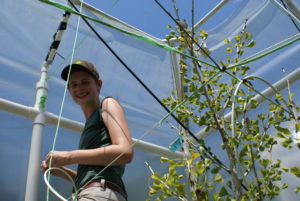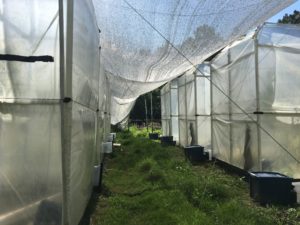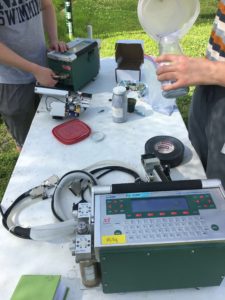by Quinn Burkhart
When the word fossil comes to mind, the first thing many people think of are dinosaurs. Of course, dinosaurs are long extinct. Yet, as crazy as it sounds, we can find ourselves walking under the shade of a special fossil that grew in the age of the dinosaurs too. We call this “fossil” a ginkgo tree–an ancient plant giving us a glimpse into the future.
All summer long, three passionate interns at the Smithsonian Environmental Research Center (SERC) have been hard at work studying a large plot of ginkgo trees that hides along one of SERC’s gravel roads. Alex Kane and Lily Bennett, two students from Haverford College, and James Sappington, a rising freshman at the University of Virginia, work alongside principal investigator Richard Barclay, a botanist who studies ancient plants at the Smithsonian’s National Museum of Natural History. Helping to complete the project are several other scientists, college professors, more than 50 on-site volunteers, and over 3,300 online citizen scientists.

SERC intern Lily Bennett fixes some technical issues in one of the carbon chambers.
Photo: Alison Haigh
This project is among the first to specifically observe ginkgo trees as markers of how plants could naturally adapt to extreme climate changes. The SERC interns find this to be an exceptionally intriguing part of their summer jobs, and have taken it upon themselves to dig deeper.
Lily Bennett, a biology major at Haverford, has formulated her own study from ginkgo seeds. Using new ginkgo seeds from older trees planted around 1930, Bennett hopes to grow them enough by the end of the summer to determine if they change biologically from their parents under controlled carbon dioxide (CO2) conditions. The “tiny baby ginkgo trees,” as Bennett affectionately calls them, are growing in small pots inside CO2 chambers next to full-grown ginkgo trees.
“I’m expecting that they will grow really fast initially and then fall off the chart abruptly when the carbon levels take their effect, but it would be extremely interesting if they didn’t,” Bennett explained. “That would actually be a little helpful, because it could help us understand how they used to adapt to natural heating.”
Bennett’s smaller project is just one of many testing ginkgos under higher carbon dioxide. The scientists are trying to understand how one of the most adaptive plants on Earth can help other plants do the same as the planet heats up.
Old Meets New
Ginkgo trees, also called “maidenhairs,” are peculiar plants. They belong to a division of ancient trees known as “Ginkgophyta”, a family that appeared on Earth 190 million years ago, when archosaurs were still walking the supercontinent Pangea. What makes ginkgo trees incredible is that they are the only species from the plant family Ginkgoaceae that was alive back then and continues to thrive today. That earned them the nickname “living fossils.” And that makes them perfect for predicting how plants of today will adapt to future global heating.
One of the of the most challenging aspects of climate science has been the fact that Earth has already endured serious periods of warming and cooling extending far back beyond human record. Although we weren’t there to say matter-of-factly how much the climate shifted or why, ginkgo trees were there. Maybe they can’t tell us the details directly, but they can help us measure how much plant species will struggle in the coming decades as the planet warms further.

A netted canopy hangs over the chamber plots, providing a little shade to interns and plants alike as they work.
Photo: Quinn Burkhart
“Because they show a long history of surviving multiple, very different eras of climates, they’re one of the only types of plants we could use to see how huge amounts of carbon in the air might affect plants later,” Sappington said.
This, specifically, is where the research between SERC, the National Museum of Natural History and Haverford comes into play. With a National Science Foundation (NSF) grant, the scientists are growing ginkgos in plastic chambers—some pumped with extra carbon dioxide up to 1000 ppm—to study how different levels of carbon dioxide affect the ginkgos’ growth.
The Early Bird Catches the Data
For most of the summer, the ginkgo plots have been in continuous rounds of 24-hour testing so the interns can accurately tell when their photosynthesis cycles are most active. This requires preparing “Milly”, the project’s machine that tests the success of photosynthesis, in the late morning. After a few ten-minute tests confirm that Milly will run properly, the interns place a clip on the machine’s tripod that radiates light over a leaf on the healthiest trees in the plot. The experiment then runs for a full day, with an intern returning to the field every 6 hours, including right before dawn, to ensure Milly is still operating and correctly calibrated.

SERC interns James and Lily work to put together and calibrate Milly, the machine used for experiments on the trees.
Photo: Quinn Burkhart
The project comes with two main goals, according to Barclay: to understand how plants like ginkgos respond to carbon dioxide changes, and to reconstruct the changes in atmospheric CO2 concentration during the Paleocene-Eocene Thermal Maximum 55 million years ago. That was a time of rapid warming and sea level rise, which scientists believe is most similar to what we’ve experienced in the last two centuries. The plot contains 9 carbon chambers that each pump in carbon dioxide to a different level. This attempts to mimic, to SERC’s best ability, the predicted levels that carbon in the atmosphere could reach in the next couple of decades.
The data from this project could generate some of the most improved climate models we have to date. With construction for the plots beginning in 2016, timing of the project is considered to have been just right—the late 2010s showed an entirely new era of global heating.
Rooting for History
Although ginkgo trees are chemically different from many other plants, predicting how they would react to human-expedited climate change, along with the knowledge of how they grew millions of years ago, can help scientists understand how modern plants may adjust as well.
All three interns say it’s exciting work, attempting to understand how other plants may adapt to the next level of climate change, just as ginkgo trees have been doing for millions of years. Understandably, the project alone is enough to give them hope for where the next generation of climate science could lead us.
“It’s pretty impressive, just looking at this entire production of research,” Kane said. “To think I get to be part of it is just awesome.”

